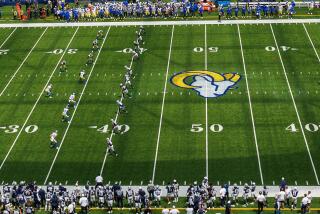Rules related to coach’s challenge for goaltender interference will change starting Wednesday
- Share via
Stung by vocal criticism over the definition of goaltender interference and the procedures in place for determining whether that offense occurred, the NHL’s Board of Governors on Tuesday approved changes to the rule pertaining to the coach’s challenge for possible goaltender interference. The key difference is that the decision to overturn a call will be made by personnel in the NHL’s Situation Room and will include the participation of a former NHL referee.
The changes to Rule 78.7(ii) were recommended last week by general managers and approved by the NHL/NHL Players Assn. competition committee and will go into effect beginning with games that will be played Wednesday. That’s unusually quick action and slightly surprising because it was initially thought that any approved changes would not take effect until the playoffs. However, repeated expressions of confusion from players and coaches about interference and how it was judged apparently spurred the league into action.
According to a statement from the NHL, here are the changes, with the new language in bold type.
(ii) Scoring Plays Involving Potential “Interference on the Goalkeeper”
(c) The standard for overturning the call in the event of a “GOAL” call on the ice is that the NHL Situation Room (which shall include a former referee in the Officiating Department in the decision-making process after reviewing any and all available replays and consulting with the Referee who made the original call, determines that the goal should have been disallowed due to “Interference on the Goalkeeper,” as described in Rules 69.1, 69.3 and 69.4.
(d) The standard for overturning the call in the event of a “NO GOAL” call on the ice is that the NHL Situation Room (which shall include a former referee in the Officiating Department in the decision-making process), after reviewing any and all available replays and consulting with the Referee who made the original call, determines that the goal on the ice should have been allowed because either: (i) there was no actual contact of any kind initiated by the attacking Player with the goalkeeper; or (ii) the attacking Player was pushed, shoved or fouled by a defending Player causing the attacking Player to come into contact with the goalkeeper; or (iii) the attacking Player’s positioning within the crease did not impair the goalkeeper’s ability to defend his goal and, in fact, had no discernible impact on the play.
More to Read
Go beyond the scoreboard
Get the latest on L.A.'s teams in the daily Sports Report newsletter.
You may occasionally receive promotional content from the Los Angeles Times.






